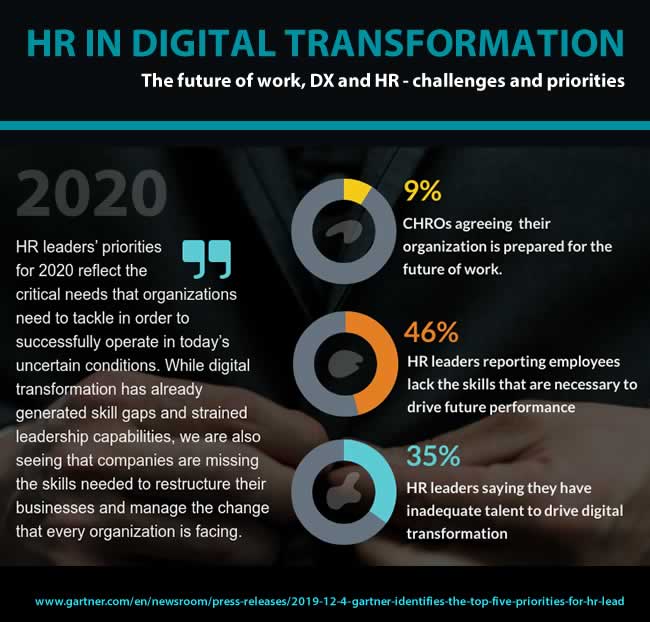A lot is being written and said about the future of work and the strategic role of HR in digital transformation. The extent to which the many predictions on the future of work effectively occur will show in the future. The fact is that ‘work’ will change and so will HR.
To ensure employees have needed skills, HR leaders should partner with business leaders to understand and maintain the proper balance of emerging, existing and legacy skill sets
There’s a consensus that HR departments should play a more strategic role in not just helping the organization tackle several (often industry-specific) challenges but also in making business transformation journeys and change/innovation initiatives possible, let alone successful — HR in digital transformation or even at the very center of digital business transformation.

The strategic role of HR in digital transformation (DX) and in supporting the enterprise in all aspects of it often is still forgotten. The same goes for the need for clear transformation strategies for HR, while digital HR maturity remains rather low. As in most business functions, the focus often is on today and the immediate future with challenges that management wants to solve first in admittedly quite complex times with uncertainties on many levels.
Any strategic transformation journey of HR departments that enables HR to take up its essential role in digital transformation needs to look at a bigger picture. It encompasses many elements, people being first, and requires a realistic view on the steps to take, including the longer-term.
As per usual, the way in which one step is taken and the degree in which it leads to tangible benefits will drive the overall – incremental – progress. Unfortunately, there’s always the risk of unexpected changes and changes regarding strategic imperatives change as new executives take over.
Yet, the essence remains. How does an organization remain relevant for its customers and for the internal customers – employees – which are needed to achieve that much? And how will the organization become profitable in a future where its core business might shift – and skills of talented people will be instrumental in guiding that process.
Digital business transformation – an ongoing enterprise HR leader priority
Discussions on the future of work typically look at different aspects of which automation, artificial intelligence, and the relationship between humans and machines are among the more popular ones.
The more interesting discussions revolve around skills for the future, reskilling and upskilling, talent management, labor shortages, employee satisfaction and happiness, the very nature, and role of work, shifting motivations among workers, and how we organize work on a societal level. And then, there’s the question of how HR teams can help HR in digital transformation enablement.
The average employee experienced 12 organizational changes in 2019, ranging from major transformations like restructuring or executive leadership transitions to more day-to-day, but still highly disruptive, changes such as moving to a new team or manager
While HR leaders look at employment, talent management, digital workplace, and workforce strategy challenges ahead, driving digital business transformation remains a priority for HR leaders in 2020.
Other key measures that should enable HR leaders to continue driving business outcomes in 2020 include 1) enhancing employee experience, 2) building the essential skills and competencies needed to grow/transform the business, 3) incorporating organizational design and change management, and 4) strengthening both current and future leadership according to Gartner.
With regards to that ‘future of work,’ only 9 percent of chief human resource officers feel their organization is prepared for it according to the company. And that’s also where these five key measures largely have their place, bringing us beyond 2020.
Preparing the business for the future of work and empowering HR in digital transformation
Leah Johnson, vice president of advisory in the Gartner HR practice, reminds us that digital transformation has already generated skill gaps and strained leadership capabilities.
An open source change approach, where HR leaders involve the right employees as active participants in making and shaping change decisions, reduces the risk that employees will become fatigued by 50%, over a traditional top-down approach

Leadership capabilities and missing skills are often mentioned as key reasons why digital transformation strategies fail to deliver and why initiatives to achieve a certain level of maturity or to overcome silos that stand in the way of success aren’t working. This is the case across ample functional areas and industries/verticals. Some examples: capabilities to leverage data and information strategically and purposefully, making IT and OT convergence succeed in a context of Industry 4.0 and, indeed, even HR transformation as such.
Yet, it’s not just about the traditional types of skills one often thinks about in the context of technologies and innovation, whatever the area might be. It’s also about the skills to restructure the business and manage change, where HR leadership is vital too.
For Johnson, HR leaders’ priorities for 2020 reflect the critical needs that organizations need to tackle in order to operate in today’s uncertain conditions successfully.
Those five priorities for HR leaders as the future of work comes closer and for HR in digital transformation in a nutshell:
- Making sure the workforce has the skills for the future whereby automation and digitalization prove to be challenging to keep up, and 46 percent of HR leaders feel employees don’t have the needed skills for future performance.
- Developing leaders and leadership skills that enable those leaders to take on rapidly expanding and changing roles, a challenge for HR leaders since 45 percent of them find it hard to develop effective midlevel leaders and over one third to develop effective senior leaders.
- Removing the barriers that keep employees from doing their work in an easier way whereby organization design and change management come in the picture. Gartner states that 57 percent of employees encounter significant barriers in their work, some of which are related to the amount of change they’ve already gone through.
- Having a clear and consistent digital transformation strategy. Forty-three percent of HR leaders state such a strategy is missing and that doesn’t make it easier to close the talent gap, of course. Moreover, 35 percent of HR leaders say they don’t have the talent to drive digital transformation.
- Doing better with regards to the employee experience and employee experience satisfaction, since per a Gartner survey, 46 percent of employees remain largely dissatisfied. With employee experience inevitably related to customer experience, and remaining an essential talent concern for HR leaders, ROI from investments in employee experience needs to increase.
HR in digital transformation: strategic steps and consideration for HR leaders
Finally, a few words on the essential role of HR in digital transformation. To make it happen, HR needs to transform as well.
46% of HR leaders report that their employees lack the skills that are necessary to drive future performance
Regardless of the technologies and existing ways to move ahead on that journey, Gartner recommends three steps to take for HR leaders to become a trusted advisor and driver with regards to digital transformation:
- Becoming digital business experts themselves;
- Leveraging talent processes;
- Making sure HR teams contribute to DX and review strategies to remain aligned with the business needs and expectations of the business and employees.

